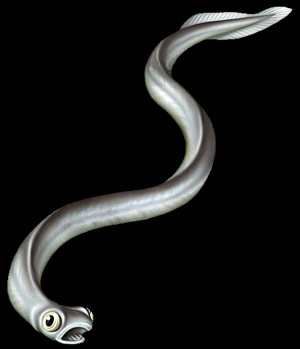- Home
- News
- General News
- Synchrotron gives...
Synchrotron gives new bite to the first vertebrates
11-05-2011
Based on new conodont fossils that were scanned on beamline ID19, a research team working at the ESRF has just published a 3D animated model that shows how these extinct marine creatures fed. Their toothed tongue was moved back and forth by a pulley-like mechanism, which was probably shared by the first vertebrates.
Share
The evolutionary origin of jaws is still unclear. To solve this enigma, researchers study most particularly those extinct or recent animals that are closest to the jawed vertebrates but do not possess jaws. Among the fossil forms, the conodonts are such animals. They were marine, eel-shaped animals that became extinct at the end of the Triassic, about 200 million years ago. Their relationship with the vertebrates is still a matter of debate but they would fit between the cyclostomes (including the recent hagfish and lampreys) and the ‘ostracoderms’ (jawless primitive fishes). A team led by paleontologist Nicolas Goudemand (University of Zurich, Switzerland) published this week in the scientific journal PNAS a work that sheds new light on how these mysterious creatures fed.
During research in the Guangxi province (South China), new, 250 million year old conodont fossils were discovered, which still partially preserve the spatial organisation of the peculiar conodont ‘teeth’. These very fragile, submillimetric fossils could be analysed thanks to the high quality of the X-ray beams available at the ESRF and they provided information that allowed reconstruction of the conodont mouth and an understanding of the way these ‘teeth’ were used.
 |
Artists impression of a conodont (Image Copyright Feenixx Publishing, Inc., www.feenixx.com). |
Based on these new fossils and the new interpretation of other articulated fossils preserving uncommon configurations of ‘teeth’, the team of scientists developed a 3D animated model, which shows that conodonts had two upper lips, each ‘armed’ with a large, fang-like tooth. They also had a ‘tongue’ bearing a complicated set of spiny, or comb-like ‘teeth’. The ‘tongue’ lay on a cartilaginous support and was moved back and forth over the support by two sets of antagonistic muscles in a pulley-like manner. Conodonts used their ‘tongue’ and their lips to grasp food. In the back of the throat, food was then processed (sliced or crushed) by two pairs of more robust, sometimes molar-like ‘pharyngeal teeth’.
 |
|
3D rendering of a cluster of four teeth of the conodont Novispathodus. Image credit: P. Tafforeau/N. Goudemand. |
These findings have implication for our understanding of the evolution of the first vertebrates. This somewhat strange feeding mechanism is actually very similar to that of modern lampreys. Therefore, this lends additional support to the interpretation that conodonts are primitive vertebrates. It shows also that the common ancestor of conodonts and lampreys, itself one of the first vertebrates, would have possessed a ‘lingual cartilage’ too and it would have feed also using a pulley-like mechanism in a manner similar to that of conodonts.
 |
|
Animated 3d reconstruction of the feeding apparatus of conodont Novispathodus (Click here or on the image above to download or launch the movie - 8 mb, mpg format). The two elements in the front (M elements) are the 'teeth' of the upper lips, the two pairs of more robust elements in the back (P elements) are the 'pharyngeal teeth' and the delicate elements in-between (S elements) are the 'lingual teeth'. In the opened position, the most lateral 'teeth' of the tongue (S3 and S4 elements) can close and grasp the prey. As the tongue starts to retract, the closing teeth pull on the prey's tissues while the central tooth of the tongue (S0 element) and the toothed lips come to close in an opposing, Y shaped motion that tears off the seized tissues. The tongue retracts further and its teeth channel the food towards the back of the throat, where it is further processed by the cutting/crushing 'pharyngeal teeth' (P elements). The teeth of the tongue appear to rotate about an inferred 'lingual' cartilage. |
Reference:
N. Goudemand, M.J. Orchard, S. Urdy, H. Bucher, P. Tafforeau, Synchrotron-aided reconstruction of the conodont feeding apparatus and implications for the mouth of the first vertebrates, PNAS early edition, doi 10.1073/pnas.1101754108.
Further information:
Detailed images and animations from the Novispathodus fossils are available in the ESRF Paleontology Database.
Top image: Reconstruction of the toothed mouth of the conodont Novispathodus based on tomographic imaging.



